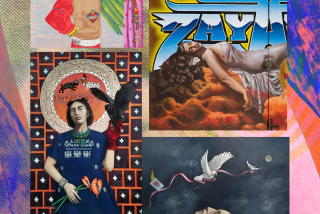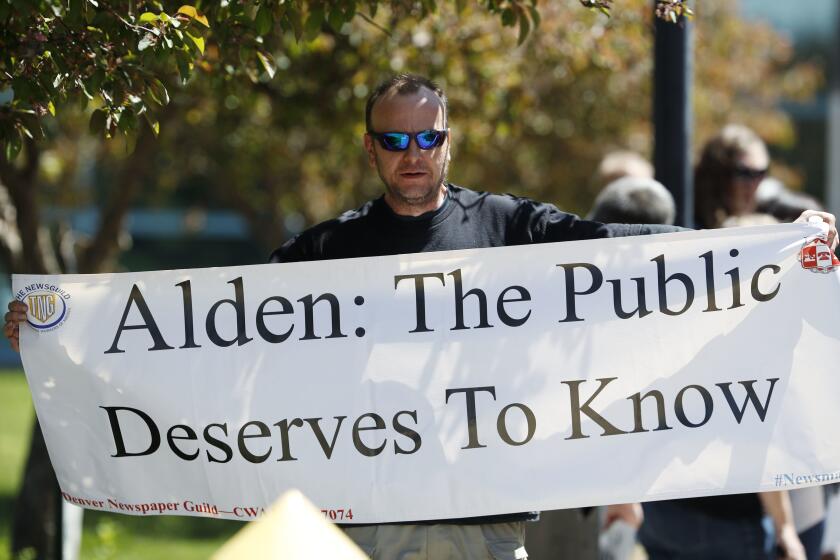L.A. exhibitions focus on Paul Outerbridge
Paul Outerbridge, one of the great pioneers of color photography, spent the last 15 years of his life in creative decline, moving from the East Coast to Laguna Beach where he opened a small portrait studio and helped his wife manage her fashion business. His photographic output during the period was meager and his once-illustrious career went into permanent eclipse.
Or so the conventional wisdom goes. Art cognoscenti like to dismiss Outerbridge’s California years (1943 to 1958) as an unfruitful period marked by failure -- a sad epilogue to a high-profile career spent mostly in New York and Europe. But two exhibitions opening soon in Los Angeles refute that long-held assumption, providing ample evidence that Outerbridge continued to push the boundaries of his art form until his final days.
“Paul Outerbridge: New Color Photographs,” opening Saturday at the Central Library, offers previously unseen images that Outerbridge took in California and Mexico that he stored away and never printed. Rare work from the period can also be found in “Paul Outerbridge: Command Performance,” a career survey that opens March 31 at the Getty Center. (The exhibitions were developed and curated independently of each other.)
These are the first major Outerbridge shows since 1981, when the Laguna Art Museum organized a retrospective for the New York-born-and-raised photographer. Together, they put Outerbridge’s late-period work into sharp focus, restoring it to its rightful place in his body of work while seeking to elevate his importance in the art world.
“I think they stand with the best of his work from New York or Paris,” said Graham Howe, an independent curator who helped organize the Central Library exhibition. The show features almost 40 color-pigment prints of photos that Outerbridge took in cities including Laguna Beach, Santa Monica and Mazatlán, Mexico. Howe purchased the images in 1980 from Outerbridge’s widow, Lois. The acquisition consisted of nearly 500 slides that were stored in small Kodak boxes gathering dust at the Outerbridge home. In a sense, they represent the long-missing final reel of his remarkable career.
For viewers, most of these photographs will reveal a spontaneity that is completely unlike the hyper-composed aesthetic that Outerbridge sharpened during his years as a fashion and commercial photographer. (During the ‘20s in Paris, he had a particular fondness for shooting nudes, an interest shared by his contemporaries Edward Weston and Alfred Stieglitz.) Untethered from his studio, he wandered the streets to shoot whatever struck his fancy, capturing the lives of ordinary working people. “You can see the same color sensibility as in his earlier work but now it is much less structured,” said William Ewing, co-curator of the Central Library exhibition.
At the same time, Outerbridge was careful never to be frivolous, according to scholars. Each picture reveals a methodical deliberation and tireless precision, whether it’s the subtle interplay of shadows with color in a photograph taken at Balboa Beach in 1950, or the geometric triangulation of sightlines in an image of workers at a Mexican seaport. “Happy accidents do not occur in color -- you get nothing for nothing,” Outerbridge wrote in his seminal book “Photographing in Color” (1940).
A multihued legacy
Outerbridge was one of the few masters of the tri-carbro-color process, a technique used to produce highly saturated color prints. The process was laborious and each print could take up to 9 1/2 hours to create because the photographer had to develop and meticulously align three separate exposures of the same image.
By the time he moved to California, consumer color photography had advanced to a stage where he no longer had to rely on that technology, but his work still retained a rich, painterly aesthetic. Other commercial photographers who broke ground in the realm of color include Edward Steichen and Margaret Watkins.
Gregarious and a bit of a social butterfly, Outerbridge was known for his generosity to younger photographers, often serving as a mentor. But he was also regarded as a difficult personality -- behavior that did nothing to ingratiate him to employers, which at one time included Condé Nast, Harper’s Bazaar and several European publications. “He always set himself up to do the hardest things possible. He knew he was good and he decided he would hold himself to a different standard,” said Paul Martineau, an assistant curator of photography at the Getty Museum.
The exhibition at the Getty features 139 prints from all periods of Outerbridge’s life, with a section dedicated to his later years in California. One photo from 1945 portrays a woman wearing a pink bow that was taken at his Laguna portrait studio. Outerbridge developed his own method of producing these miniatures by placing a white board behind an overexposed Kodachrome transparency and sealing them in a moisture-proof glass enclosure.
Outerbridge’s devotion to color cost him dearly in the eyes of art critics and tastemakers, according to Martineau, who curated the Getty exhibition. “People didn’t know how to judge color photographs then. It was a high-cost process so people associated it with commercial endeavors,” he said. “But Outerbridge knew color would eventually replace black-and-white photography. He was ahead of his time in many ways.”
Talents overlooked
The fact that it’s taken nearly 28 years for Outerbridge’s work to return to the spotlight speaks to the virtual veil that has enshrouded his career for decades -- a combination of lingering critical neglect and East Coast cultural chauvinism. While historians have enshrined William Eggleston and other members of the New Photography movement of the ‘60s and ‘70s, Outerbridge remains in the shadows even though his work in tri-carbro-color photography predates and even anticipates the younger generation.
The scarcity of Outerbridge’s work is also the result of more mundane circumstances: the diluting dispersal of his photographs among private collectors and the copyright rules that protect his work.
After he died of lung cancer in 1958 at 62, his widow sold or donated his work to various museums around the country, but the most significant portions of the estate ended up in the hands of two parties: the Laguna Art Museum and L.A. art dealer G. Ray Hawkins. The Laguna Art Museum deaccessioned much of its Outerbridge holdings in the mid- to late-’90s, prompting criticism from some art scholars who cited the collection’s historical importance to the city.
For his part, Hawkins acquired and then sold Outerbridge’s personal archives (21 boxes’ worth of material) to the Getty Research Institute. But the gallerist retains a sizable collection of Outerbridge’s photographs as well as the copyright over most of his body of work. Hawkins, who is currently serving time in federal prison in Taft, Calif., on unrelated charges dealing with income-tax evasion, said in a phone interview that he still owns a “very nice amount” of Outerbridge’s photographs “but not enough. I buy Outerbridges back whenever I can.”
The Getty’s exhibition took two years to organize, mostly because the museum staff had to track down his work all over the world. (There are 42 art institutions worldwide that hold Outerbridge photographs.)
The reemergence of his California photographs adds another twist to a career that for decades has been underappreciated and misunderstood. “Being out of the limelight gives an artist a certain freedom,” said Phillip Prodger, co-curator of the Central Library show. “When he settled in Laguna, he had the opportunity to pursue things because he loved them. In that way, he pursued a photography that, I think, is very pure.”
More to Read
The biggest entertainment stories
Get our big stories about Hollywood, film, television, music, arts, culture and more right in your inbox as soon as they publish.
You may occasionally receive promotional content from the Los Angeles Times.











